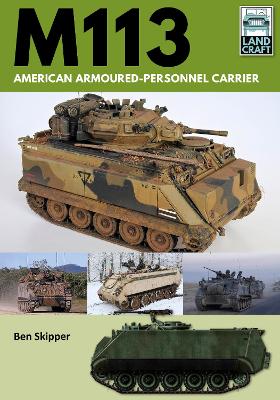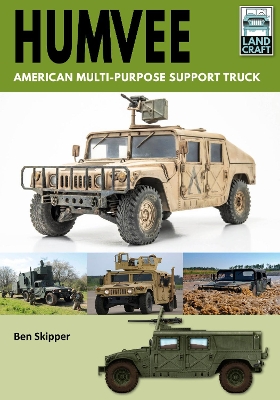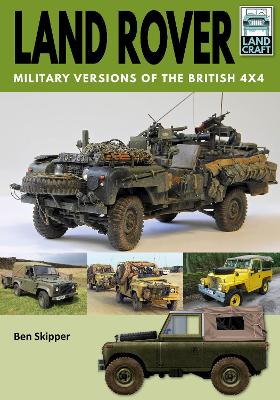Land Craft
3 total works
The M113 has become as much a recognisable part of the US military machine at war as the Bell UH-1 Iroquois and M16 assault rifle. Earning its stripes in the jungles and highlands of Vietnam, it became the most widely armoured vehicle of the campaign. Such was its prowess that the Viet Cong gave it the nickname Green Dragon on account of its ability to go virtually anywhere.
Its ground-breaking aluminium hull gives the M113 a relatively low weight of 12ts, this allows it to be easily transported by air and gives it an amphibious ability. The design was also easy to modify and can carry a range of support and indirect fire weapons. From mortars to ballistic missiles, the M113 spawned a progeny of useful and innovative vehicles.
The base M113 is lightly armoured and safe against only the lightest of small arms fire and shell splinter. As a result a range of up-armour packages have been used in the past, from sandbags to complex applique armour.
80,000 M113s of all types have been produced and are in use with over 50 countries, making it one of the most widely used armoured fighting vehicles to be produced. Indeed such was its popularity that the US bought their final M113s in as late as 2007.
The M113 was designed and developed by the Food Machinery Corporation (FMC) to replace the heavier and less reliable steel-bodied M59 and M75 armoured personnel carriers. It was specifically designed to be lighter, air-portable and have amphibious capability. Carrying a crew of two, driver and commander, who manned the M113's only weapon, a .50cal machine gun, the M113 would transport 11 soldiers into combat before withdrawing to the rear.
Powered initially by a V8 petrol engine the M113 would be continuously up-engined throughout its frontline and subsequent rear support lifespan. Changes included improved suspension, smoke dischargers and externally fitted fuel tanks. Other changes have included armoured commander's turrets and slat armour.
This LandCraft title looks at the M113s development where the FMC sought to utilise its chassis into as many roles as possible, from smoke generators to flamethrowers. The book also looks at how the M113 was adapted for use by numerous overseas customers and how these are upgraded to suit local conditions.
Finally the title looks at the M113's changing roles in the more sophisticated contemporary battlescape and how it's still providing service in theatres across the world in a variety of roles, both combat and support.
For the modeller there is nothing more important than the little things and this image-rich section of Land Crafts M113 title delivers the goods. Filled with crisp photos that show the M113's many details, combined with helpful accompanying text, forms an enviable visual guide for the enthusiast and modeller alike.
Its ground-breaking aluminium hull gives the M113 a relatively low weight of 12ts, this allows it to be easily transported by air and gives it an amphibious ability. The design was also easy to modify and can carry a range of support and indirect fire weapons. From mortars to ballistic missiles, the M113 spawned a progeny of useful and innovative vehicles.
The base M113 is lightly armoured and safe against only the lightest of small arms fire and shell splinter. As a result a range of up-armour packages have been used in the past, from sandbags to complex applique armour.
80,000 M113s of all types have been produced and are in use with over 50 countries, making it one of the most widely used armoured fighting vehicles to be produced. Indeed such was its popularity that the US bought their final M113s in as late as 2007.
The M113 was designed and developed by the Food Machinery Corporation (FMC) to replace the heavier and less reliable steel-bodied M59 and M75 armoured personnel carriers. It was specifically designed to be lighter, air-portable and have amphibious capability. Carrying a crew of two, driver and commander, who manned the M113's only weapon, a .50cal machine gun, the M113 would transport 11 soldiers into combat before withdrawing to the rear.
Powered initially by a V8 petrol engine the M113 would be continuously up-engined throughout its frontline and subsequent rear support lifespan. Changes included improved suspension, smoke dischargers and externally fitted fuel tanks. Other changes have included armoured commander's turrets and slat armour.
This LandCraft title looks at the M113s development where the FMC sought to utilise its chassis into as many roles as possible, from smoke generators to flamethrowers. The book also looks at how the M113 was adapted for use by numerous overseas customers and how these are upgraded to suit local conditions.
Finally the title looks at the M113's changing roles in the more sophisticated contemporary battlescape and how it's still providing service in theatres across the world in a variety of roles, both combat and support.
For the modeller there is nothing more important than the little things and this image-rich section of Land Crafts M113 title delivers the goods. Filled with crisp photos that show the M113's many details, combined with helpful accompanying text, forms an enviable visual guide for the enthusiast and modeller alike.
With its characteristic wide track, low silhouette and its distinctively deep exhaust note the Humvee sets itself apart from the range of light utility trucks it replaced. Fully air-portable, the Humvee features an aluminium body seated on a steel ladder chassis, powered by a 190hp V8 engine.
Introduced into service in 1985, the Humvee remained pretty much unnoticed until its baptism of fire during the invasion of Panama in Operation Just Cause. It wasn't until almost a year later, in Operation Desert Shield and Desert Strom that the Humvee really came into the public eye.
As a result of its newly found fame its manufacturer, American Motors General, started to produce a civilized version for public consumption, with sales and profile boosted by Hollywood patronage. At the same time the Humvee continued to serve in some of the most dangerous US operations undertaken to date. From the streets of Mogadishu to the Balkans, the Humvee developed into a vehicle far removed from its original design intentions.
With some 17 variants now in service, from the basic troop carrier to the awesome Avenger Anti-Aircraft system, this Humvee LandCraft title provides the modeller with a rich vein of inspirations and subject.
This title looks at the process behind the design and development of the Humvee and how American Motors General were able to fulfil a complex design brief to deliver a single vehicle that was able to replace a host of in-service vehicles. This title will chart how the Humvee grew from a light utility truck into a versatile platform whose modesty hides its potential.
With its specially designed track, impressive ground clearance, waterproofed electronics and ability to carry a one tonne load, the first Humvees were light years ahead of the vehicles they replaced. With its unique suspension and transmission systems to its unique engine arrangement this 4x4 is capable of feats normally only afforded to tracked vehicles.
With some 17 versions in US service the Humvee fulfils its traditional role as cargo and troop carrier as well as special-weapons platform, ambulances, Direct Air Support vehicles and communications shelter vehicles.
After 35 years of service the Humvee has changed from soft skinned run-about to a lightly armoured force protection asset. Fitted with a larger engine, inter-changeable armour, specially designed escape windows and a unique blast chimney, the Humvee's story is indeed proof that development of military vehicles never stops.
For the modeller there is nothing more important than the little things and this image-rich section of LandCrafts' Humvee title delivers the goods. Filled with crisp images that chart the Humvee's development, combined with informative accompanying text, forms an enviable visual guide for the enthusiast and modeller alike.
Introduced into service in 1985, the Humvee remained pretty much unnoticed until its baptism of fire during the invasion of Panama in Operation Just Cause. It wasn't until almost a year later, in Operation Desert Shield and Desert Strom that the Humvee really came into the public eye.
As a result of its newly found fame its manufacturer, American Motors General, started to produce a civilized version for public consumption, with sales and profile boosted by Hollywood patronage. At the same time the Humvee continued to serve in some of the most dangerous US operations undertaken to date. From the streets of Mogadishu to the Balkans, the Humvee developed into a vehicle far removed from its original design intentions.
With some 17 variants now in service, from the basic troop carrier to the awesome Avenger Anti-Aircraft system, this Humvee LandCraft title provides the modeller with a rich vein of inspirations and subject.
This title looks at the process behind the design and development of the Humvee and how American Motors General were able to fulfil a complex design brief to deliver a single vehicle that was able to replace a host of in-service vehicles. This title will chart how the Humvee grew from a light utility truck into a versatile platform whose modesty hides its potential.
With its specially designed track, impressive ground clearance, waterproofed electronics and ability to carry a one tonne load, the first Humvees were light years ahead of the vehicles they replaced. With its unique suspension and transmission systems to its unique engine arrangement this 4x4 is capable of feats normally only afforded to tracked vehicles.
With some 17 versions in US service the Humvee fulfils its traditional role as cargo and troop carrier as well as special-weapons platform, ambulances, Direct Air Support vehicles and communications shelter vehicles.
After 35 years of service the Humvee has changed from soft skinned run-about to a lightly armoured force protection asset. Fitted with a larger engine, inter-changeable armour, specially designed escape windows and a unique blast chimney, the Humvee's story is indeed proof that development of military vehicles never stops.
For the modeller there is nothing more important than the little things and this image-rich section of LandCrafts' Humvee title delivers the goods. Filled with crisp images that chart the Humvee's development, combined with informative accompanying text, forms an enviable visual guide for the enthusiast and modeller alike.
After the Second World War many American military vehicles become surplus stock and soon found their way into the hands of farmers and land owners across Great Britain. The subsequent heavy use and the real possibility of difficulties obtaining spares led Maurice Wilks, the Rover Car Company Chief Engineer, to design and build a replacement. Not only would the new Land Rover fill a gap in Rover's portfolio, but also bring in much needed post-war money.
Intended as a stop gap, the Land Rover would cease production almost 68 years later, after a production run that had produced over two million vehicles. During that time it would transform how the military saw and used motor transport. From utilitarian General Service truck to cutting-edge weapon's platform the Land Rover would prove its worth time and again.
This latest LandCraft title looks at the design and development of the Land Rover as well as the military specific variants designed and built, including the famous SAS Pink Panther, the nimble Light Weight and powerful Forward Control gun tractor. The title will also look at those key conversions that took place on standard Land Rovers throughout the duration of its life span.
From the humble beings of the box like Series 1 to the formidable firepower and pace of the WOLF WMIK, the Land Rover was a constantly improved military vehicle. Through numerous trials, lessons learned and operational requirements the Land Rover was a vehicle that grew with the times.
This LandCraft title removes some of the mystique that surrounds the myriad versions and how the Land Rover developed. It also includes the story of the design and development of the exclusively military Light Weight and Forward Control versions. It also charts how the Land Rover became a virtual barometer for the technological and engineering developments that have occurred over the past 70 years.
It demonstrates how the Land Rover's flexibility to change was its core strength. How the innovation of Rover and military mechanical engineers created a series of unbeatable military trucks.
This section also looks at the smaller, important developments and variations in design which showed how adaptable the Land Rover really was. From specialist signals line layers to first responder fire and rescue vehicles, to the unit- and theatre-led changes, the Land Rover was a vehicle that took all in its stride, proving its versatility.
For the modeller there is nothing more important than the little things and this image-rich section of LandCraft's Land Rover title delivers the goods. Filled with crisp images, that chart the Land Rovers development, combined with detailed accompanying text, forms an enviable visual guide for the enthusiast and modeller alike.
Intended as a stop gap, the Land Rover would cease production almost 68 years later, after a production run that had produced over two million vehicles. During that time it would transform how the military saw and used motor transport. From utilitarian General Service truck to cutting-edge weapon's platform the Land Rover would prove its worth time and again.
This latest LandCraft title looks at the design and development of the Land Rover as well as the military specific variants designed and built, including the famous SAS Pink Panther, the nimble Light Weight and powerful Forward Control gun tractor. The title will also look at those key conversions that took place on standard Land Rovers throughout the duration of its life span.
From the humble beings of the box like Series 1 to the formidable firepower and pace of the WOLF WMIK, the Land Rover was a constantly improved military vehicle. Through numerous trials, lessons learned and operational requirements the Land Rover was a vehicle that grew with the times.
This LandCraft title removes some of the mystique that surrounds the myriad versions and how the Land Rover developed. It also includes the story of the design and development of the exclusively military Light Weight and Forward Control versions. It also charts how the Land Rover became a virtual barometer for the technological and engineering developments that have occurred over the past 70 years.
It demonstrates how the Land Rover's flexibility to change was its core strength. How the innovation of Rover and military mechanical engineers created a series of unbeatable military trucks.
This section also looks at the smaller, important developments and variations in design which showed how adaptable the Land Rover really was. From specialist signals line layers to first responder fire and rescue vehicles, to the unit- and theatre-led changes, the Land Rover was a vehicle that took all in its stride, proving its versatility.
For the modeller there is nothing more important than the little things and this image-rich section of LandCraft's Land Rover title delivers the goods. Filled with crisp images, that chart the Land Rovers development, combined with detailed accompanying text, forms an enviable visual guide for the enthusiast and modeller alike.


